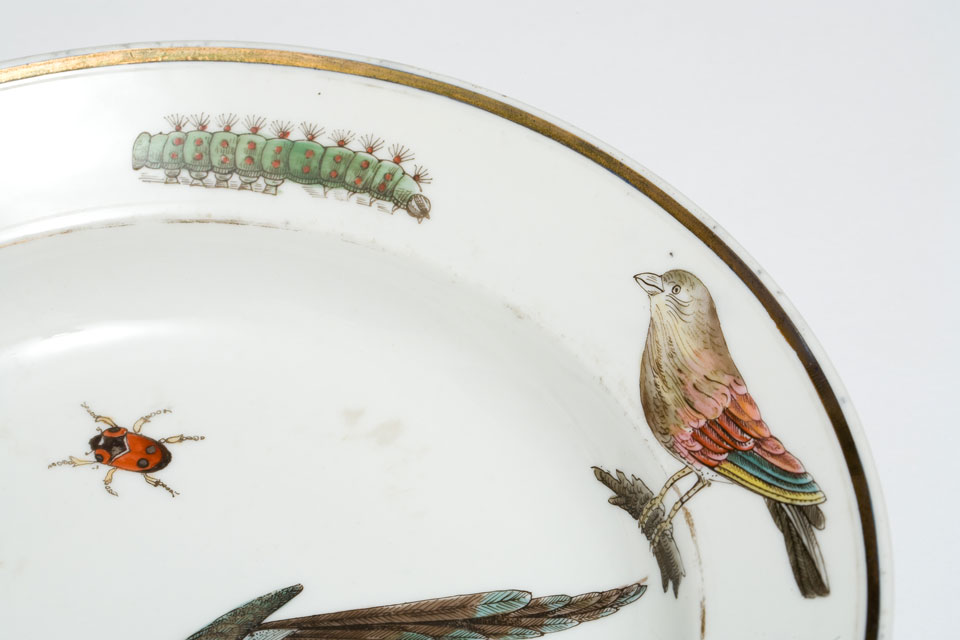Bird-spotting from home | Russian porcelain plate with birds and insects

Photography: Ellie Laycock.
BIRD-SPOTTING FROM HOME | RUSSIAN PORCELAIN PLATE WITH BIRDS AND INSECTS (c.1840)
Each week, whilst we are closed to the public due to Covid-19, we are collating a newsletter with our partner venue Stanley Picker Gallery, highlighting recent projects, collection items and an activity suggestion to keep you inspired and creative at home. With the clocks going forward marking the arrival of Spring, the theme for today’s newsletter, Thursday 2 April is bird-spotting from home.
Artists, architects, designers and craftspeople have represented birds in their work for centuries. Birds feature in rock paintings, drawings, portraits, still-life and landscapes, paintings of gardens and interiors, in carvings and as sculpture. Bird motifs can also be found in many different materials and patterned fabrics in our homes, as well as on our clothing.
Pictured above is a mid-19th century soup dish featuring birds and insects, a favourite amongst our team and visitors alike. We believe the bird depicted in this detail of the plate is based on a finch, judging by its beak. The dish is one of a number of highly decorative examples of Imperial Russian porcelain in the Dorich House Museum Russian Collection, many of which were included in Richard Hare’s illustrated history, The Art and Artists of Russia (1965). The condition of the dish suggests it was never used, but we love to imagine it filled with the sweet beetroot soup that Dora Gordine made for visitors. We’ve just added an image of the plate to the Collections section of our website, where you can view other highlights of the Dorich House Museum Collections.
Dorich House Museum and Stanley Picker Gallery are both located in areas where there is plenty of bird-life. At Dorich House Museum, on Kingston Vale on the edge of leafy Richmond Park, robins, wrens, blackbirds, jackdaws, magpies, and the more exotic ring-necked parakeets can be seen and heard in the garden. Meanwhile at the Stanley Picker Gallery, situated on an island on the Hogsmill river, herons, ducks, coots, moorhens, kingfishers and pied wagtails can be seen near the gallery and along the river by Kingston School of Art. Last year, yellow wagtails visited for the summer from Africa.
With our current quieter environment, you might have heard bird song at dawn and dusk more clearly. Or you might have had time to watch the birds, whether these are pigeons, sparrows, starlings, gulls, or garden birds like robins, blackbirds, blue-tits, great-tits, coal-tits, goldfinches or thrushes.
Below is the dawn chorus recorded on 1 April, 2020 by Catherine Sidwell, Town House Project Coordinator at Stanley Picker Gallery.
Here are some links to learn more about birds, birdsong and the influence of birds in art & design:
BBC Radio 4’s Tweet of the Day
British Library’s Archive of bird songs
Self-Isolating Bird Club on Twitter
RSPB Breakfast Birdwatch
Kingston University’s Biodiversity Blog
Springwatch on BBC2
Countryfile on BBC1
The Lost Words by Robert Macfarlane & Jackie Morris
Biodiversity Heritage Library
The Lark Ascending by Vaughan Williams
Swan Lake by Tchaikovsky
The Cuckoo and the Nightingale by Handel
Carnival of the Animals by Saint-Saens
Catalogue d’Oiseaux by Messiaen
William Morris at the V&A
C.F.A Voysey at the V&A
The bird knowledge in this News post comes from Catherine Sidwell, Town House Project Coordinator at Stanley Picker Gallery and PhD candidate at Kingston School of Art.
View this week’s newsletter online here and visit the Stanley Picker Gallery website to subscribe.

